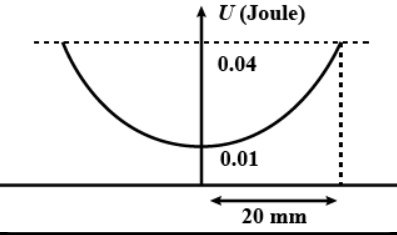
The variation in potential energy of a harmonic oscillator is as shown in the figure. The spring constant is

A. \[1 \times {10^2}N{m^{ - 1}}\]
B. \[1.5 \times {10^2}N{m^{ - 1}}\]
C. \[0.0667 \times {10^2}N{m^{ - 1}}\]
D. \[3 \times {10^2}N{m^{ - 1}}\]
Answer
219k+ views
Hint: The term potential energy refers to the energy that has been stored or the energy that has been caused by its location. The potential energy of an object changes mostly when the object is lower or higher than its original position.
Formula Used:
\[PE = {V_0} + \dfrac{1}{2}k{x^2}\]
where PE is the potential energy, \[{V_0}\] is the initial energy, k is the spring constant and x is the displacement travelled by the string.
Complete step by step solution:
We have been given that the initial energy of the harmonic oscillator is 0.01 J and its final potential energy is 0.04 J. The spring of the harmonic oscillator has travelled 20 mm or 0.02 m. We have to find the spring constant of the oscillator. Let \[{V_0}\] be the initial potential energy, PE be the final potential energy, x be the distance travelled by the string, and k be the spring constant.
By using the formula of the potential energy of the harmonic oscillator, we get,
\[PE = {V_0} + \dfrac{1}{2}k{x^2} \\
\Rightarrow 0.04 = 0.01 + \dfrac{1}{2}k{\left( {0.02} \right)^2} \\
\Rightarrow 0.03 = 0.0002k \\
\Rightarrow k = 150N{m^{ - 1}} \]
Writing the result in the scientific notation we get,
\[k = 150N{m^{ - 1}} \\
\Rightarrow k = 1.5 \times 100N{m^{ - 1}} \\
\therefore k = 1.5 \times {10^2}N{m^{ - 1}} \]
So, option B, \[1.5 \times {10^2}N{m^{ - 1}}\] is the required solution.
Note: As the harmonic oscillator initially had some potential energy and after applying the spring its potential energy gets increased so to calculate the spring constant we only need the energy generated by the spring. So, for the energy generated only by spring, we subtract the initial potential energy from the final potential energy.
Formula Used:
\[PE = {V_0} + \dfrac{1}{2}k{x^2}\]
where PE is the potential energy, \[{V_0}\] is the initial energy, k is the spring constant and x is the displacement travelled by the string.
Complete step by step solution:
We have been given that the initial energy of the harmonic oscillator is 0.01 J and its final potential energy is 0.04 J. The spring of the harmonic oscillator has travelled 20 mm or 0.02 m. We have to find the spring constant of the oscillator. Let \[{V_0}\] be the initial potential energy, PE be the final potential energy, x be the distance travelled by the string, and k be the spring constant.
By using the formula of the potential energy of the harmonic oscillator, we get,
\[PE = {V_0} + \dfrac{1}{2}k{x^2} \\
\Rightarrow 0.04 = 0.01 + \dfrac{1}{2}k{\left( {0.02} \right)^2} \\
\Rightarrow 0.03 = 0.0002k \\
\Rightarrow k = 150N{m^{ - 1}} \]
Writing the result in the scientific notation we get,
\[k = 150N{m^{ - 1}} \\
\Rightarrow k = 1.5 \times 100N{m^{ - 1}} \\
\therefore k = 1.5 \times {10^2}N{m^{ - 1}} \]
So, option B, \[1.5 \times {10^2}N{m^{ - 1}}\] is the required solution.
Note: As the harmonic oscillator initially had some potential energy and after applying the spring its potential energy gets increased so to calculate the spring constant we only need the energy generated by the spring. So, for the energy generated only by spring, we subtract the initial potential energy from the final potential energy.
Recently Updated Pages
Two discs which are rotating about their respective class 11 physics JEE_Main

A ladder rests against a frictionless vertical wall class 11 physics JEE_Main

Two simple pendulums of lengths 1 m and 16 m respectively class 11 physics JEE_Main

The slopes of isothermal and adiabatic curves are related class 11 physics JEE_Main

A trolly falling freely on an inclined plane as shown class 11 physics JEE_Main

The masses M1 and M2M2 M1 are released from rest Using class 11 physics JEE_Main

Trending doubts
JEE Main 2026: Application Form Open, Exam Dates, Syllabus, Eligibility & Question Papers

Derivation of Equation of Trajectory Explained for Students

Hybridisation in Chemistry – Concept, Types & Applications

Understanding the Angle of Deviation in a Prism

Understanding Collisions: Types and Examples for Students

Understanding Atomic Structure for Beginners

Other Pages
JEE Advanced Marks vs Ranks 2025: Understanding Category-wise Qualifying Marks and Previous Year Cut-offs

Units And Measurements Class 11 Physics Chapter 1 CBSE Notes - 2025-26

NCERT Solutions For Class 11 Physics Chapter 8 Mechanical Properties Of Solids

Motion in a Straight Line Class 11 Physics Chapter 2 CBSE Notes - 2025-26

NCERT Solutions for Class 11 Physics Chapter 7 Gravitation 2025-26

How to Convert a Galvanometer into an Ammeter or Voltmeter




